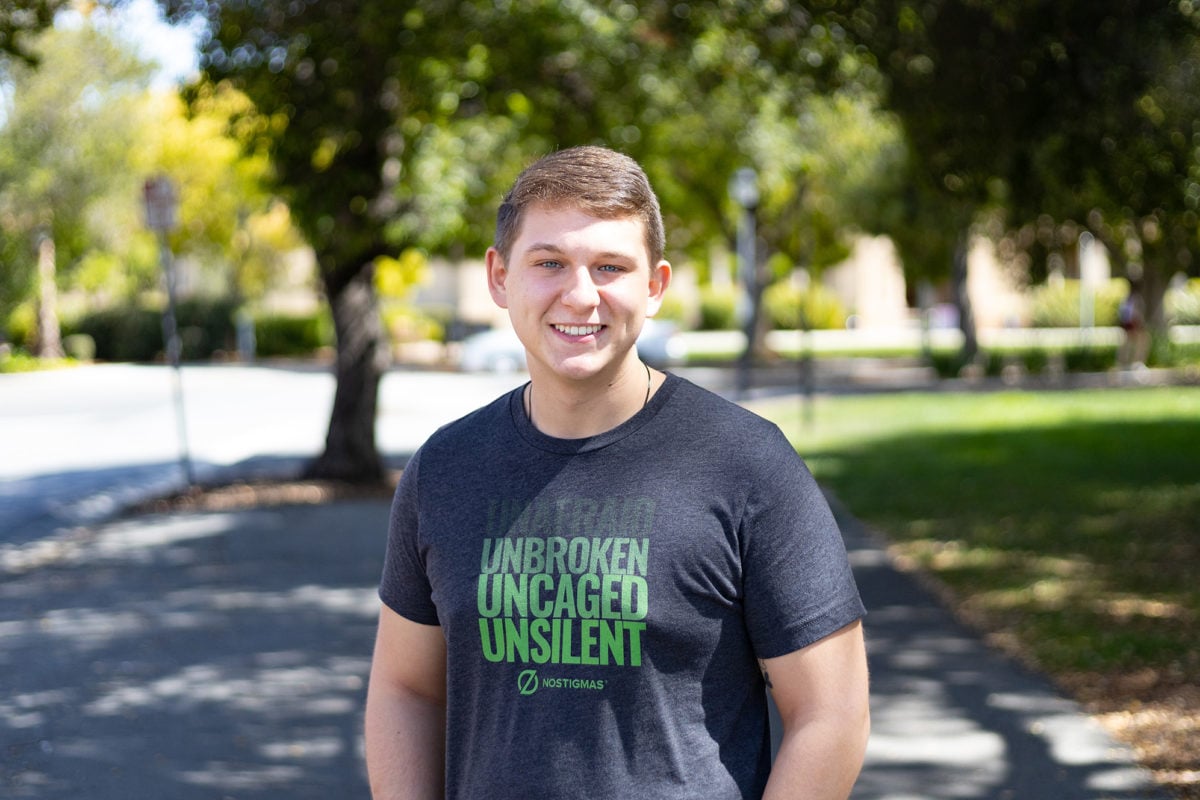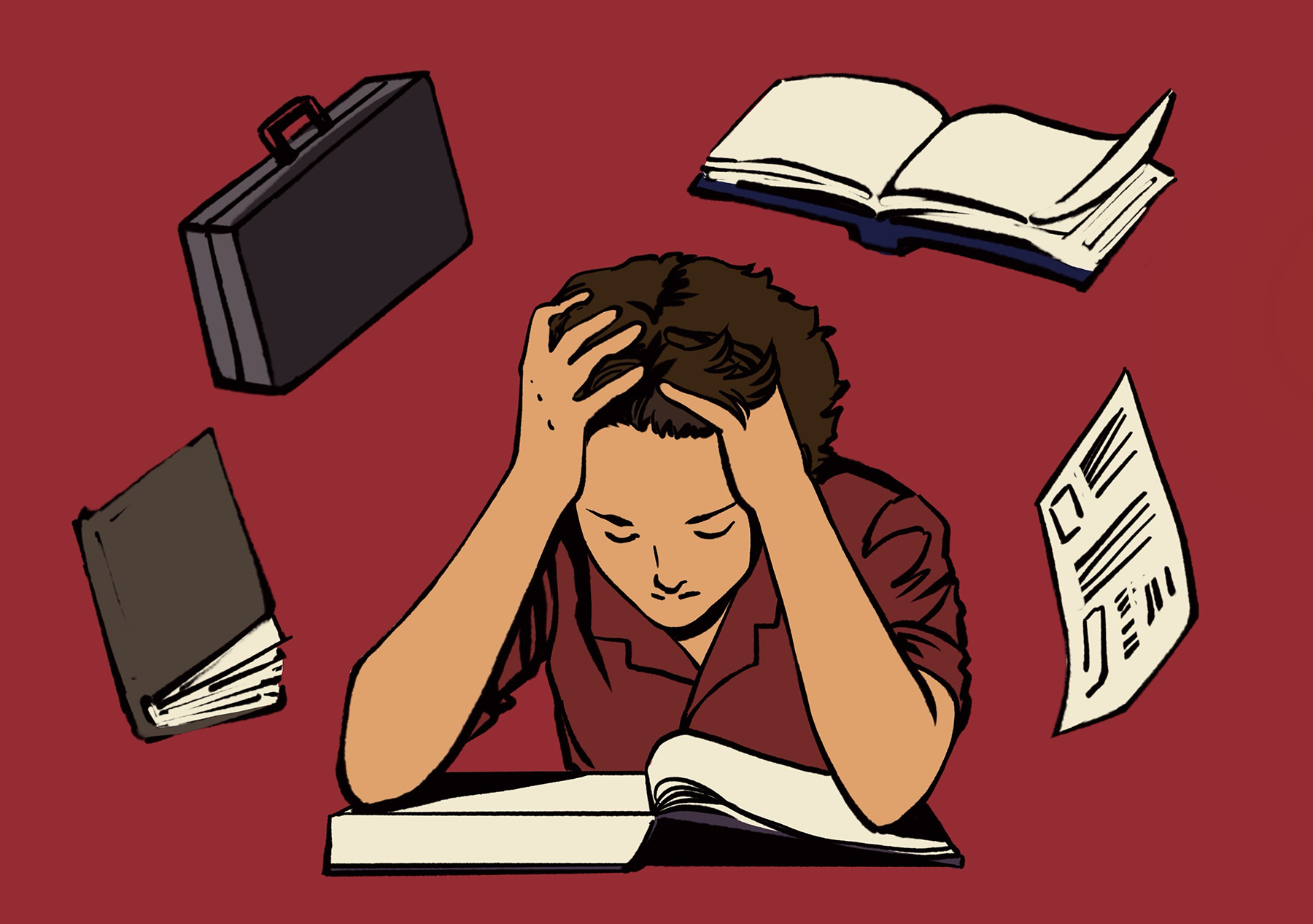Content warning: this article contains references to suicide. If you or someone you know is in need of help, you can call the National Suicide Hotline at 800-273-8255.
Taylor Malina ’24 had already been struggling with her mental health for some time when the COVID-19 pandemic hit. Amid social-distancing regulations and periods of long-term isolation, her symptoms were exacerbated due to the loneliness and anxiety that came with the global health crisis.
“Everything was really accentuated for me, because my mom was immunocompromised, so we weren’t really leaving the house,” Malina said. “At a certain point, it became increasingly difficult to reach out for connection, and I was getting stuck in these spirals and not sure how to get myself out of them.”
According to Malina, these downward “spirals” characterized much of her frosh year at Stanford.
Now, more than two quarters into a relatively “normal” school year, Malina says she has adjusted to campus life, and is finding healthy coping mechanisms to deal with enduring challenges. One of these outlets, she said, was a Stanford class called “Laughter & Play for Wellbeing,” which took a whole new approach to mental health.
“It was less of a problem-and-solution manual,” Malina said. “It was more proactive in that it was recognizing that you are already a whole person — but you can really get a lot out of these exercises by forming vulnerable connections.”
Like Malina, many students who struggled with their mental health during the pandemic say that the return to in-person school has positively impacted their mental well-being.
“Transitioning from virtual to in-person learning was a significant adjustment for students, and navigating covid-related uncertainties added to the stress,” Counseling and Psychological Services (CAPS) Operations Director Oliver Lin told The Daily. “Students have expressed relief and gratitude at being able to connect with one another again in person.”
The return to normal has also been a huge relief for students whose mental illness struggles escalated into crisis over the pandemic.
For example, Nina ’23 (pseudonym) has struggled with suicidal thoughts, self-harm urges, emotional dysregulation and mood swings her whole life. The pandemic heightened these symptoms, ultimately leaving her in a state of emergency.
“When I first started college, I felt that I had a good support system, and thought my mental health was doing a lot better than it had before,” Nina said. “When the pandemic started and there were a lot of sudden changes for people, including having to leave campus abruptly, I felt as though my support system had been ripped out from under me, and that I had lost any progress I made in my mental health all at once.”
For Nina, the isolation induced by the pandemic led to increased suicidal thoughts, and after an attempt, she was sent to a treatment center where she received help throughout much of the pandemic.
According to Nina, her experience at the center, coupled with the return to in-person school, was integral in getting her to a stable place.
“That combination — it saved my life,” she said.
Rebecca Pizzitola ’25 had a similar experience. Like Nina, she credits the return to normalcy with a positive turning point in her mental wellbeing.
“The pandemic exacerbated my depression a lot,” Pizzitola said. “The only thing that kept me getting up in the morning was going to school, so the fact that I had to sit in my room all day doing school made my depression and anxiety that much worse.”
She says she hasn’t suffered a major depressive episode since arriving on campus for her frosh year in the fall. “After spending 15 months doing school online in my room, just having a change in environment and more autonomy helped a lot.”
Coming back to in-person school has had a positive impact on many students’ mental health. Yet for others, it brought on a new set of challenges.
“Many students have experienced stress and anxiety through the re-entry process,” Lin said.
One stressor, according to Malina, is the fact that members of her class — the sophomore class — are all trying to integrate despite having had vastly different experiences during the covid year. For some members of the Class of 2024, the last academic year consisted of living at home with parents, caring for sick individuals and social isolation. For others, it looked like forming connections with classmates through living in different places around the country.
“The sophomore class felt divided at the beginning of the school year,” Malina said.
For others who struggle with social anxiety or generalized anxiety, re-integrating into a fast-paced, social environment has been difficult.
CAPS Clinical Director Amy Wilkinson said, “Many Stanford students are now existing from a new, often destabilized baseline as they strive to obtain an education in a very competitive and fast-paced environment. We hear from students that they feel they are going against the prevailing Stanford culture when they acknowledge systemic stressors, or when they prioritize basic things like adequate rest, social connection, caring for family or mental health care.”
A junior who asked to remain anonymous for privacy reasons said, “I think at first I had more social anxiety coming back to school than anticipated — and that became more apparent as time went on.”
One downside of coming back to in-person school, the student said, is comparing yourself to others more frequently.
“I think that social comparison is definitely more common now that I am around more people,” the junior said. “I think comparison can trigger a lot of anxiety or feelings of inadequacy, and it has also brought up feelings of inadequacy in my body image.”
The student said, however, that a silver lining of the mental health struggles so many people experienced during the pandemic is a “shared experience of hardship” that has deeply bonded them to many of their peers.
“Everyone experienced covid so differently — but having some sort of shared struggle allowed me to feel closer to my peers. Whereas, coming to Stanford I felt as though I was alone in my struggles,” the student said.
A senior who also asked to be identified by class year for privacy reasons agreed that the pandemic impacted their mental health in both positive and negative ways.
“I think in some ways it made things worse, in terms of overall anxiety about what’s going on in the world and uncertainty — but in other ways it made it easier because of decreased social interaction,” the senior said.
The student, who accesses therapy and psychiatry through CAPS and off-campus referrals, said that the transition back to in-person school was more difficult than anticipated.
“I take over 20 units every quarter, so commuting to classes takes a lot of time, and I completely underestimated how hard the transition from online learning to in-person learning would be,” the student said.
The student added that the pandemic really allowed them to slow down, so the return to school felt very rapid.
“I was consistently less busy during the pandemic — a complete shift from what I was used to — so coming back to the rush of school was so difficult,” the student said.
But the 2021-22 school year has been difficult for reasons beyond the transition back to in-person learning, according to both CAPS clinicians and students. Amid international turmoil, including Russia’s war on Ukraine, students are left with uncertainty and anxiety.
“Stanford is an international community, with at least a quarter of the student population being international students,” Wilkinson said. “Many are also first-generation students in the United States. Traumas from war and conflict affect members of our international community intensely. Their communities, their families and their sense of basic safety are threatened. It is critical that we come together as a community to support students when they are impacted by events in their home countries.”
Stanford affiliates have also experienced several devastating losses of students in the past 12 months — losses which experts say have significantly affected the fabric of the community.
Helen Hsu, CAPS Outreach Director, said, “The loss of several students in these past years has been hugely impactful on the entire community. Grief is a long-term process, and some members of the community are more affected due to previous losses or stressors.”
For some Stanford students, suicide hits very close to home.
Conner Oberhauser ’25 was only 14 years old when he attempted to take his life. His suicide attempt followed years of debilitating social anxiety that made it difficult for him to interact with peers and go about his daily life.
“Every time I spoke I felt like I did something wrong,” Oberhauser said. “It got so bad that I wasn’t able to speak to my friends — I would just go home straight to my room.”
After his attempt, Oberhauser was admitted to a psychiatric ward, where he was put on medications and treated with cognitive behavioral therapy (CBT).
“I had to actively work and tell myself that these things weren’t true — that I am not worthless, that I do have value,” the frosh said. “But I knew that if I wanted my mental health to get better, it’s something that I had to take control of.”
Channeling his struggles into action, Oberhauser started a public-speaking platform — he went around to conferences and schools in his home state of Nebraska to talk about combating mental health stigma.
When coming to Stanford for the 2021-22 school year, Oberhauser said he expected all of his problems to disappear.
“Like many students, when I got into my dream school, I expected to be living my dream every day,” he told The Daily. “But classes are hard, and it definitely does affect your mental health, especially when it’s a common experience to base our worth on our grades, on productivity and what we get done.”

Oberhauser says he has struggled to balance friendships, work, exploring campus, extracurricular activities and all of the other things with which students engage in their first few quarters on campus.
Moreover, he said, like other students, he found transitioning out of the pandemic as someone with social anxiety to be difficult.
According to Oberhauser, what truly helped him stay grounded was getting an Office of Accessible Education (OAE) letter for classes to help mitigate some of the challenges that come with dealing with anxiety and ADHD.
“Just having that letter — not even using it — takes a lot of anxiety away,” he said.
When asked what advice he would give to someone currently struggling, Oberhauser had three things to say.
“The first piece of advice I’d give is to accept that you are going through something. If you don’t accept it, you won’t be able to get help.”
His second piece of advice was to reach out “to friends, family, professors, RAs, RFs or the suicide hotline number — because although mental illness is so stigmatized, it’s not something you should ever have to go through on your own.”
Finally, he said, “You need to want to get better. It’s not something that anyone else can do for you.”
The aforementioned junior student emphasized that students should never be afraid to share their struggles with loved ones.
“Sharing your struggles doesn’t burden the people that care about you,” she said. “You deserve love and care. Sometimes when initially seeking support, you might initially be faced with discomfort and support that doesn’t feel helpful, and it can be a process to connect with the right people that adequately meet you where you’re at and address your needs. So be patient — healing takes time.”
